Ten years isn’t a particularly long time in the car industry.
It’s about the lifespan of some models. Long enough for one trend to fade and another to appear, perhaps, or for a new segment-leading car to rise to prominence, or for an old one to sink into obscurity.
That’s usually enough drama for one decade. In car industry terms, however, the past 10 years have held as much turmoil and upheaval as the average geological epoch. In 2012, the Tesla Model S had yet to launch. The Paris Climate Accords to which Donald Trump would one day make the US deaf were still three years away from even being agreed. On our side of the pond, there wasn’t even a Euro 6 emissions standard in place for engineers to aim a ‘defeat device’ at, and so our love affair with diesel was still in its sooty, NOx-tacular full bloom.
Other than the Tesla Roadster, only three mainstream production electric cars had been developed to the point of global sale: the Nissan Leaf, the Mitsubishi i-MiEV and the Renault Fluence ZE. Across the whole of Europe, fewer than 8000 examples of those three cars combined would be sold that year. Saab registered more cars than that the year before it went bankrupt (2011).
Without wishing to put too fine a point on it, a supertanker load of s*** has gone down since then, hasn’t it? Dieselgate, Brexit, an economic downturn, the UK announcing a 2030 ICE ban, a global pandemic, another economic downturn, a computer-chip shortage: a new crisis every minute.
But there’s no catalyst quite like uncertainty. Who would’ve believed, back in 2012, how many car makers would have committed themselves to a fully electrified future by 2022? And, by the same time, that two powerhouses of the European luxury car industry would themselves be so devoted to the electrification transition as to have introduced totemic zero-emission halo models?
Something seismic has shifted at the top of the car market. The sustainable future of luxury transport, as produced by two of the most prolific and successful makers of luxury cars that the 20th century ever knew, is now with us. The all-electric Mercedes-Benz EQS and BMW iX are here.
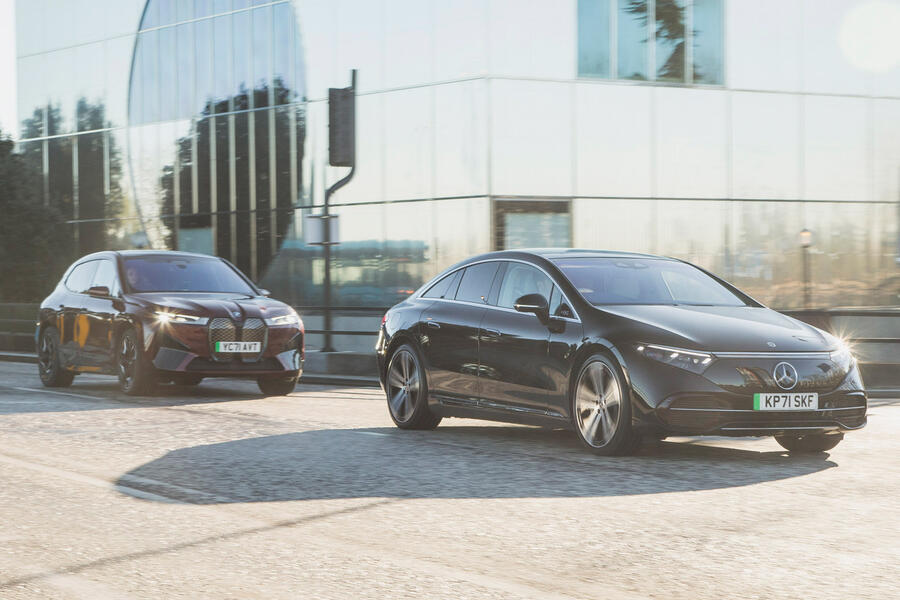
So which would you have, dear reader: the gigantic potato or the angry-looking, semiaquatic rodent? Some first-world problems, you might well observe, are quite nice not to have. Somewhat perfunctory gags aside, though, the better question for us to ponder for a couple of thousand words or so is which might you pick, were you to find yourself in such a ‘fortunate’ position, for the very slickest, easiest and most convincing transition to a fully electric, modern and sustainable, charmed motoring life? If you haven’t jumped already, is now the time? Having spent a couple of long winter days in both of them, exploring their real-world driving, charging, carrying and cosseting qualities up hill, down dale, in town and on busy A-road, perhaps we can now at least begin to answer that.
We will start with a simple but important observation: both of these cars, in their own particular ways, feel like clear and identifiable progress for the EV. Dismissing either for superficial reasons wouldn’t be wise if you’re serious about spending big money on an EV any time soon. Whatever their particular strengths, priorities, preferences, quirks and shortcomings, they’re both state of the art, just as they should be. Having been disrupted, the German car industry establishment has returned fire with interest.
These cars both do things and offer things that no other EV quite like them has before. The iX xDrive50 is a luxurious high-performance SUV with the range to leave the Audi E-tron S stranded; handling appeal that would most likely stand up next to the Jaguar I-Pace; and refinement and cabin appeal that put it in a different league altogether to the Tesla Model X. It’s a versatile, enveloping and unexpectedly characterful car, with a completeness of static and dynamic qualities that position it a sizeable evolutionary step beyond its direct rivals.
The EQS 450+ is even more daring, though, even longer-legged and even more committed to the notion that it can transport its occupants into another motoring world. It’s undoubtedly the braver car: a limousine with the looks of a space capsule and an interior that could have been lifted straight from a far-sighted show car from not very long ago, back when such cars still had shows to go to.
The EQS’s interior aims to stun you with its bright reflective hides, silvery features and digital technology the likes of which you’ve never seen. It’s a classic limousine in some ways, not unlike the Mercedes-Benz S-Class to ride in at a basic level, with very similar passenger space – although its wedgier, more slavishly aerodynamic body design makes it look quite different on the outside. It shares much with the S-Class in terms of driving ergonomics and secondary controls also. But when it comes to in-car technology, it pulls out all the stops with its imposing, full-width Hyperscreen touch-controlled digital fascia.
This isn’t quite what it seems, though. If you’re a real technophile and have had visions of dragging display screens and menu consoles around across the whole surface of this car’s dashboard, almost like Tom Cruise in Minority Report – choosing and scaling exactly what information you want to see, precisely where and how you want to see it – prepare for reality to dawn.
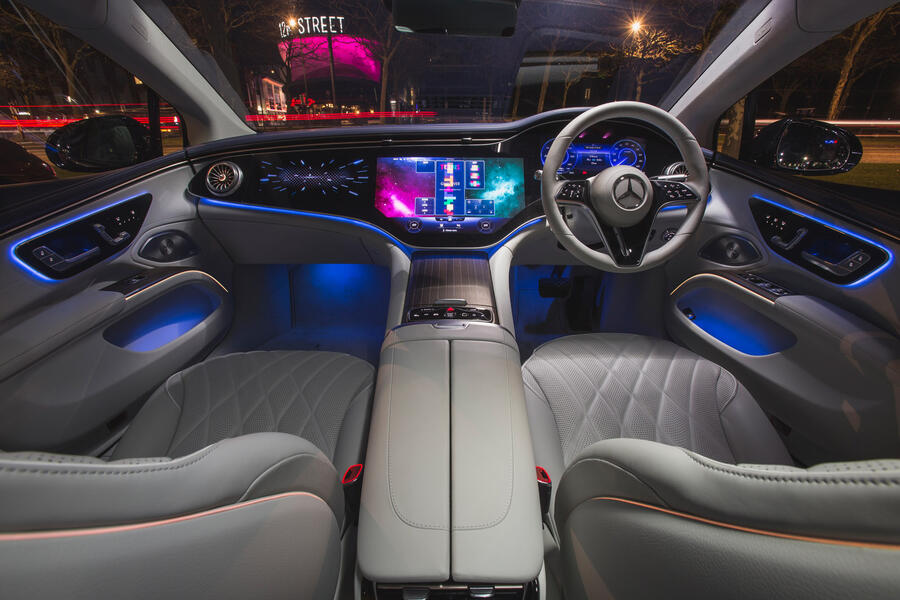
What the Hyperscreen really offers (and it’s a £7995 option on all trim levels) is an additional 12in touchscreen display for your front passenger; an enlarged 18in central display that otherwise works like Mercedes’ familiar top-level MBUX infotainment system; a large augmented reality head-up display; and a fingerprint scanner (with which the car recognises its driver when they get in and configures itself to their preferences).
Allowing for the standard digital instruments, Mercedes has effectively fronted the several smaller screens to make it look like one continuous, configurable, super-large one, but it’s a trick. Everything works, looks good and does what it’s supposed to. You can even play Tetris on it, Tesla fans. But separate passenger screens and giant head-up displays, however crisp and clear they may look and however welcome you may be to have them, have been seen before. There’s nothing revolutionary here.
The iX, in parallel, introduces BMW’s Operating System 8.0 – but it hasn’t been weaponised like the Hyperscreen, and it sits within a cabin design that looks a lot less like a sketch from a 1990s graphic novel and puts you at ease much more effectively.
The iX counters the EQS’s wide-eyed futurism with a warmer, more idiosyncratic and less formal flavour, both inside and out. It’s a likeable car, this: a slow-burner, perhaps, especially if you’re not a fan of the look of that ‘intelligence panel’ (which is what we’re now calling a radiator grille when it’s not a radiator grille, I gather).
In general, the iX is less of an alien than the EQS; it’s easier to fit in somewhere. It’s clearly an i car, recognisable from its exposed ‘carbon cage’ chassis sections to its open footwells, two-spoke steering wheel, ‘floating’ control displays and pinched C-pillar. It’s a bit like they supersized the BMW i3.
The interior is a lovely place: not just super-spacious, but enveloping, considered, neatly styled, genuinely expensively appointed and just a little bit understated. It’s like the German luxury design idiom as we know it, just updated and rationalised; whereas, for one domineering reason, the EQS’s cabin is more like some outlandish fantasy.
To drive, then. Even though one is a saloon and the other a much taller SUV, there’s only 105kg between these cars’ kerb weights. The BMW is the heavier, nudging over two and a half tonnes.
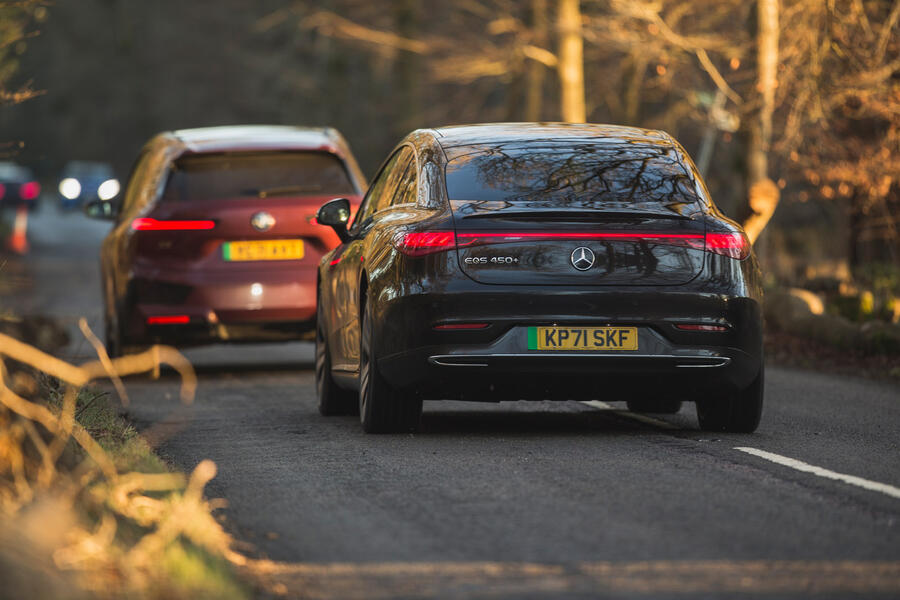
Both have usable battery capacity of just above 100kWh and both offer DC rapid charging at up to 200kW. Both blood all-new, mixed-metal, EV-dedicated platforms and both use all-corner adaptive air suspension and four-wheel steering.
So much, so comparable. But since the Mercedes is the entry-level act in its particular model range, it has ‘only’ one motor, one driven axle and 329bhp. The BMW, being mid-range (and an SUV to boot), gets two motors, four-wheel drive and 516bhp.
Send your £100,000 to Stuttgart, then, and you will get the lower, sleeker, slower but longer-range EV that might well better suit your daily transport requirements. Mercedes advertises a range of up to 453 miles for the car, depending on specification, and that’s certainly a figure with a lot of clout.
In sub-10deg C test conditions and in response to some gently intensive use both in town and out of it, we saw more like 350 to 380 miles promised from the trip computer of our upper-level EQS. But in warmer temperatures, on slightly smaller wheels and in more typical touring cruising, I Lighting is now a big design focus and grilles aren’t grilles can well imagine this could be a real-world 400-mile prospect when you needed it to be. Not driven at faster motorway speeds, regardless of conditions or without regard for efficiency, granted. But even so, it’s the first EV that I’ve driven to even threaten to genuinely, dependably break that particular range watershed – and not just in the test laboratory but out on the street.
The BMW, by contrast, gives you more of everything – except, perhaps, the thing you might worry the most about (real-world range here, under the same conditions, was between 265 and 290 miles). The iX is more spacious and airy than the EQS, and it’s marginally more practical for cargo carrying (the gap between the cars isn’t huge in the latter respect, but the BMW’s boot is bigger with the rear seats folded down, and it could also carry the bulkier loads).
The EQS has all the accessible performance that a luxury EV really needs. It would make a diesel S-Class seem heinously unresponsive and slow, and it has wonderful, assured, linear drivability at all times. But the iX is quite a lot faster again, if you want big performance in your £100,000 luxury SUV as well as laid-back refinement. Its electrically excited motors seem to conjure even better response than the EQS’s, plus they have longer-lasting stamina as speeds rise.
Four-wheel steering transforms the lowspeed handling of both cars, but the EQS’s even more markedly than the iX’s. The Mercedes is a 5.2m-long saloon with rear wheels that can mirror the fronts by as much as 10deg. You can turn it on a sixpence like a black cab and it’s remarkably easy to hold tight to an urban apex or nip around a tight roundabout or a tight car park. The BMW feels a touch bigger when manoeuvring but still hides its bulk very cleverly. Its body control is a little tauter at speed than the EQS’s, although it exposes you to lateral movement on even roads, because it has that higher hip point.
But it’s a supple, quiet, filtered and genteel ride we want from our big luxury beasts, isn’t it? Even in 2022 and even when we’ve got 500bhp under our ever-responsible big toe. And especially if so much else about the technical make-up of the luxury car we’ve chosen seems ready to create that idealised bubble of hyper-refinement that we’ve imagined.
Well, there is a car here that rides better and quieter. For this tester, it’s at least the moral victor of this contest. The isolation and sophistication of the iX’s ride is really very special indeed. Both of our test cars rode on optional 22in wheels, but the iX’s cushioned, deft ride made the EQS’s actually seem a little clunky at times, over the very sharpest edges and nastiest craggy ruts.
The EQS rides softly; it wafts, sure enough. But it trips up occasionally too, when you can suddenly tell it’s riding on big rims with little in the way of tyre sidewall. By contrast, you might quite reasonably assume that the BMW’s wheels were a good two inches smaller; no doubt in part because its SUV wheel arches make room for that bit more sidewall anyway, but also simply because it smothers, smudges and filters away the nastiest parts of the surface so much more consistently.
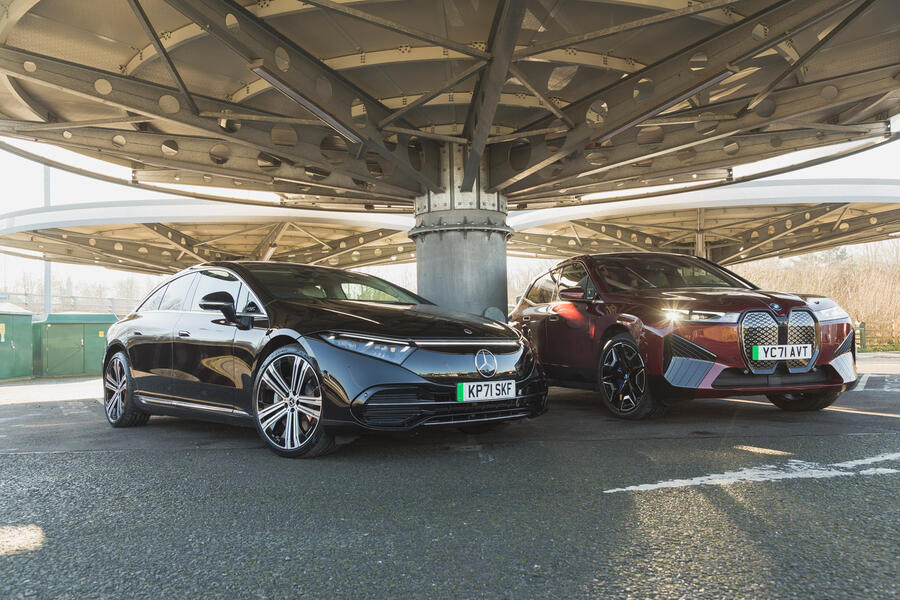
You could say there’s one good reason to pick the Mercedes here, and many more the BMW; or you could say there are 400 good reasons to decide the other way. I reckon you would be over-simplifying a complicated equation that has just played itself out here in either case, so different are the contrasting philosophies that have produced these forward-looking flagship models.
But the completeness, the thoroughness and the unexpected informality of the iX mark it out as the superior car overall – to me, at least. By being more versatile and inclusive and that bit less stuffy and monolithic than the EQS, it feels more modern than 100 digital touchscreens could compensate for. It feels more like a luxury car ready to take us to the next age of personal transport, rather than one that just has come from it. And I know which of those I would rather get into.

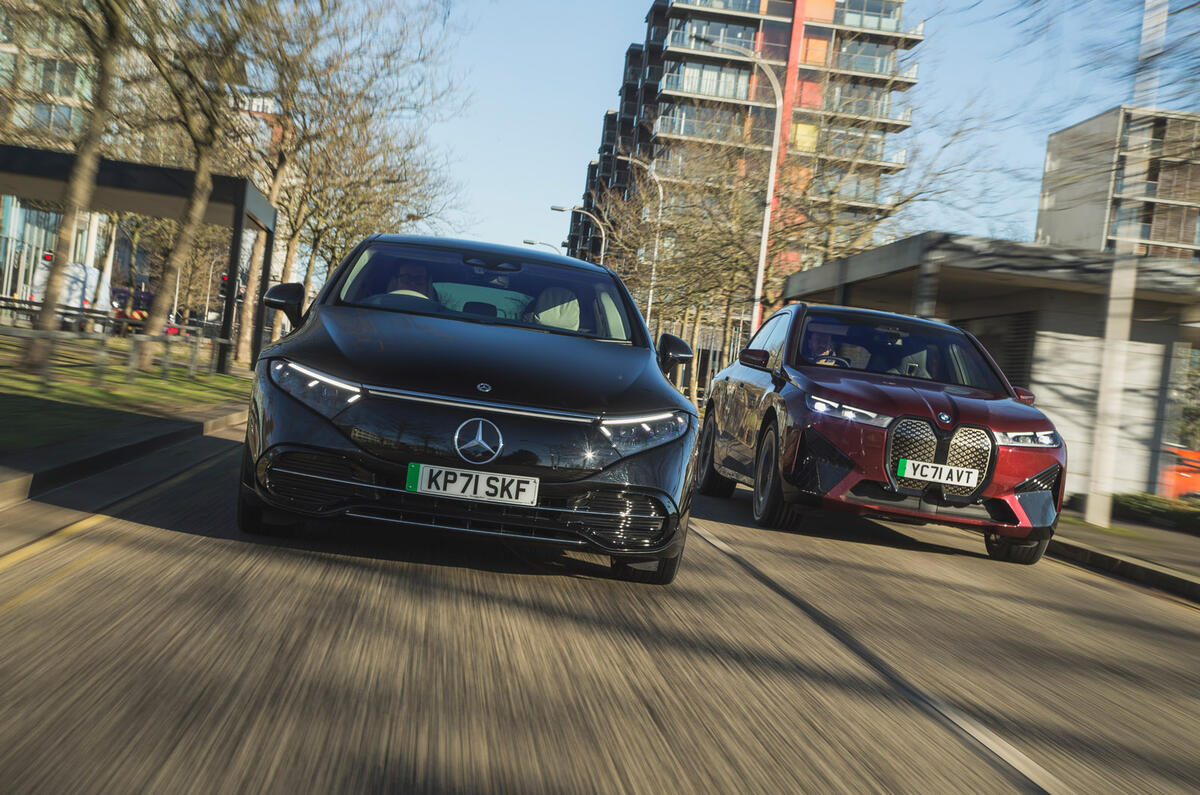





















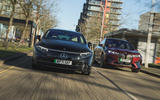



























Join the debate
Add your comment
I know I am in the miniority, but the iX has totally grown on me. It isn't pretty, but it is striking in design.
BMW has to be congratulated on producing a design that's uglier than the X6. That it's even more embarrassing in the flesh is even more remarkable. Nice colour.
Have the manufacturers of European electric cars done a quiet deal with the German government and voluntarily limited the speed of their EVs to below 130mph ?
Both these top-end BMW and Mercedes cars have far lower top speeds than their equivalent IC-engined models.